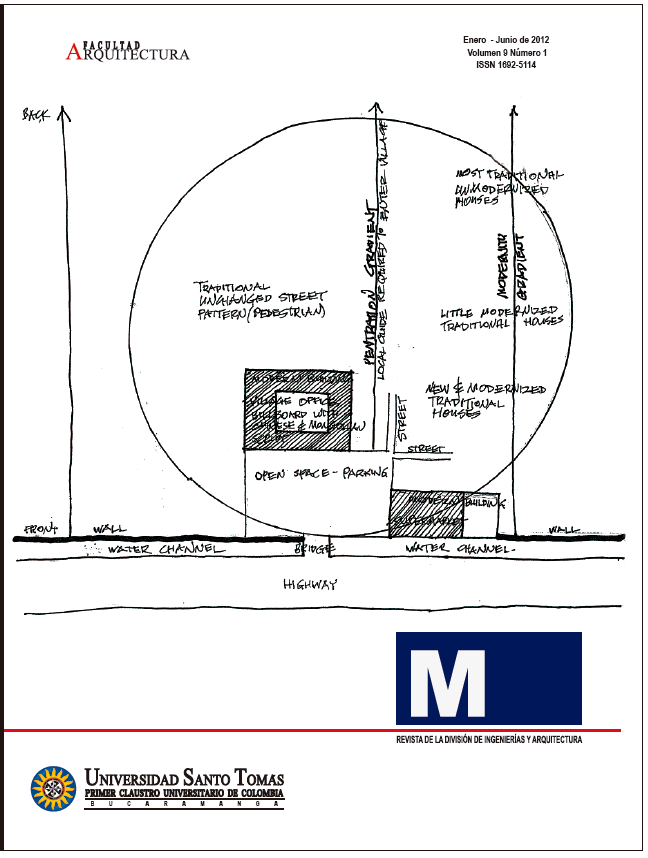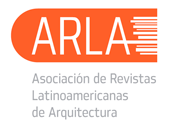BIOMÍMESIS EN ARQUITECTURA E INGENIERÍA ESTRUCTURAL
Resumen
La biomímesis tiene una gran cantidad de aplicaciones en prácticamente todos los campos científicos, académicos y profesionales. En las últimas décadas, esta “nueva” ciencia ha tomado mucha fuerza debido a que las aplicaciones que se han llevado a cabo han sido satisfactorias, lo que demuestra el potencial de su uso. En el presente documento se expone sucintamente el significado de biomímesis y se presentan algunas de las aplicaciones que puede tener en el campo de la Arquitectura y de la Ingeniería Civil. Estas aplicaciones están divididas, según el criterio y el interés de los autores en el tema, en tres grandes grupos: la forma, los procesos, y la estructura. Dentro de cada uno de estos grupos se exponen ejemplos concretos que se han implementado, o que se piensan implementar, en el diseño arquitectónico y estructural. Por medio de los ejemplos presentados se puede ver el enorme potencial que puede llegar a tener el uso generalizado de la biomímesis en todo el campo del diseño y la construcción de objetos arquitectónicos.
ABSTRACT
Biomimicry has a huge quantity of applications in almost all scientific, academic and professional fields. In the last decades, this “new” science has taken a lot of strength because of the successful applications that have been carried out, demonstrating the potential of its use. In the present document is exposed, in a concise way, the meaning of biomimicry and is also presented some of the applications that this science can have in the field of Architecture and Civil Engineering. According to the criteria and to the specific interest of the authors, these applications are divided in three principal groups: form, processes and structure. Inside of each one of these groups there are exposed some particular examples that have been implemented, or that are thought to be implemented, in architectonic and structural design. Through these examples it can be seen the great potential that a generalized use of biomimicry in all the field of design and construction of architectural objects can have.
Referencias
BENYUS, Janine (1997), Biomimicry: Innovation Inspired by Nature. New York, Harper Perennial.
BYRNE, J.; Fenton, M.; Hemberg, E.; McDermott, J.; O’Neil, M.; Shotton, E. y Nally, C. (2011) “Combining structural analysis and multi-objective criteria for evolutionary architectural design”, En: Applications of Evolutionary Computation, pp.204-213.
CHANDRUPATLA, Tirupathi y BELEGUNDU, Ashok (2002), Introduction to Finite Elements in Engineering. New Jersey, Prentice-Hall.
COELLO, C.A. y Christiansen, A.D. (2000) “Multiobjective optimization of trusses using genetic algorithms”, En: Computers and Structures, No.75, pp. 647-660.
COELLO, Carlos; LAMONT, Gary y VAN VELDHUIZEN, David (2007), Evolutionary Algorithms for Solving Multi-Objective Problems. New York, Springer Science+Business Media.
CRESPO CABILLO, I. (2005), Control gráfico de formas y superficies de transición [tesis doctoral], Barcelona, Universitat Politécnica de Catalunya.
FIALHO, A.; Hamadi, Y. y Schoenauer, M. (2011) “Optimizing Architectural and Structural Aspects of Buildings towards Higher Energy Efficiency”, En: Proceedings of the 13th Annual Conference Companion on Genetic and Evolutionary Computation GECCO’11, New York, ACM, pp.727-732.
FOGEL, Lawrence Jerome; OWENS, Alvin J. y WALSH, Michael John (1966), Artificial Intelligence through simulated evolution. Chichester, UK, John Wiley.
GAGNE, J.M.L. y Andersen, M. (2010) “Multi-objective facade optimization for daylighting design using a Genetic Algorithm”, En: Proceedings of SimBuild 2010 - 4th National Conference of IBPSA-USA.
GASPAR-CUNHA, A.; Loyens, D. y Van Hattum, F. (2011) “Aesthetic Design Using Multi-Objective Evolutionary Algorithms”, En: EMO’11 Proceedings of the 6th International Conference on Evolutionary Multi-Criterion Optimization, Heidelberg, Springer-Verlag, pp.374-388.
HOLLAND, John H. (1975), Adaptation in natural and artificial systems. Ann Arbor, MI, University of Michigan Press.
KICINGER, R.; Arciszewski, T. y De Jong, K. (2005) “Evolutionary computation and structural design: A survey of the state-of-the-art”, En: Computers and Structures, No.83, pp.1943-1978.
LI, G.; Zhou, R.G.; Duan, L. y Chen, W.F. (1999) “Multiobjective and multilevel optimization for steel frames”, En: Engineering Structures, No.21, pp.519-529.
MARTÍN, Esteban y CARRANZA, Andreu (2007), La Clave Gaudí. Bogotá, Random House Mondadori.
MATHEWS, F. (2011) “Towards a Deeper Philosophy of Biomimicry”, En: Organization and Environment, No.24, pp.364-387.
MATTHECK, Claus (1998), Design in Nature. Berlin, Springer-Verlag.
McDONOUGH, William y BRAUNGART, Michael (2002), Cradle to Cradle: remaking the way we make things. New York, North Point Press.
NEUROHR, R. y Dragomirescu, C. (2007) “Bionics in engineering – defining new goals in engineering education at politehnica University of Bucharest”, En: International Conference on Engineering Education – ICEE 2007. Coimbra, Portugal.
NOILUBLAO, N. y Bureerat, S. (2011) “Simultaneous topology, shape and sizing optimization of a three-dimensional slender truss tower using multiobjective evolutionary algorithms”, En: Computers and Structures, No.89, pp.2531-2538.
PUGNALE, A. y Sassone, M. (2007) “Morphogenesis and structural optimization of Shell structures with the aid of a Genetic Algorithm”, En: Journal of the International Association for Shell and Spatial Structures, No.48, pp.161-166.
RECHENBERG, I. (1965), Cybernetic solution path of an experimental problem [Library Translation 1122], Farnborough, UK, Royal Aircraft Establishment.
SASSONE, M. y Pugnale, A. (2008) “Optimal design of glass grid shells with quadrilateral elements by means of a genetic algorithm”, En: Proceedings of the 6th International Conference on Computation of Shell and Spatial Structures IASS-IACM 2008: Spanning Nano to Mega.
SASSONE, M.; Méndez, T. y Pugnale, A. (2008) “On the interaction between architecture and engineering: the acoustic optimization of a reinforced concrete shell”, En: Proceedings of the 6th International Conference on Computation of Shell and Spatial Structures IASSIACM 2008: Spanning Nano to Mega.
SCHWEFEL, H.P. (1965), Kybernetische Evolution als Strategie der experimentelen Forschung in der Stromungstechnik [Tesis de Maestría], Berlín, Hermann Fottinger Institute for Hydrodynamics, Technical University of Berlin.
SIVANANDAM, S.N. y DEEPA, S.N. (2012), Introduction to Genetic Algorithms. Berlin, Springer-Verlag.
STEVENS, Peter (1987), Patrones y pautas en la naturaleza. Barcelona, Salvat Editores.
TÁRRECH, Armand Puig (2011), La Sagrada Familia según Gaudí. Barcelona, El Aleph Editores.
TURNER, J. y Soar, R. (2008) “Beyond Biomimicry: What termites can tell us about realizing the living building”, En: First International Conference on Industrialized, Intelligent Construction – I3CON. Leicestershire, UK.
TYREE, M. (2003) “The ascent of water”, En: Nature, No.423, p.923.
TYREE, Melvin y ZIMMERMANN, Martin (2002), Xylem Structure and the Ascent of Sap. Berlin, Springer.
VINCENT, J. (2006) “Applications: Influence of Biology on Engineering”, En: Journal of Bionic Engineering, No.3, pp.161-177.
VOGEL, Steven (2000), Cat’s Paws and Catapults: mechanical worlds of nature and people. New York, W.W. Norton & Company.
WANG, S.; Lim, K.; Khoo, B. y Wang, M. (2007) “An extended level set method for shape and topology optimization”, En: Journal of Computational Physics, No.221, pp.395-421.
WANG, W.; Rivard, H. y Zmeureanu, R. (2006) “Floor shape optimization for green building design”, En: Advanced Engineering Informatics, No.20, pp.363-378.
WINSLOW, P.; Pellegrino, S. y Sharma, S.B. (2010) “Multi-objective optimization of free-form grid structures”, En: Struct Multidisc Optim, No.40, pp.257-269.
YIATROS, S.; Wadee, M. y Hunt, G. (2007) “The load-bearing duct: biomimicry in structural design”, En: Engineering Sustainability, No.160, pp.179-188.







